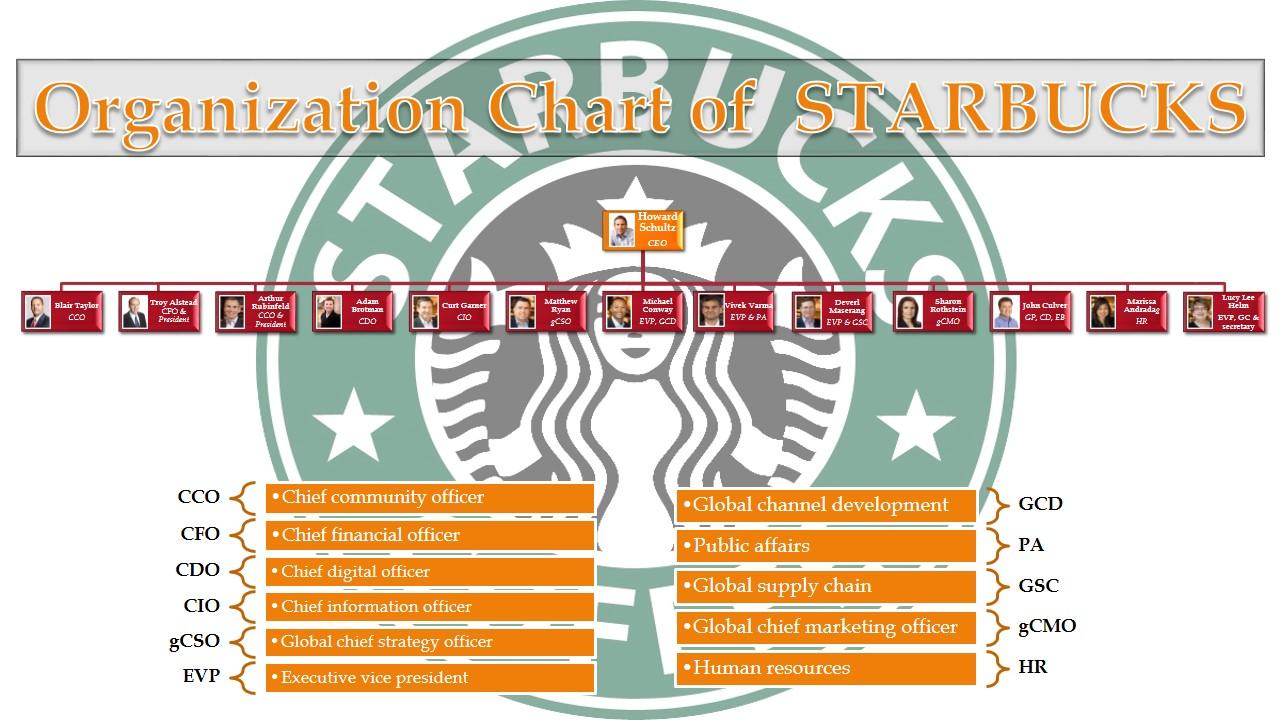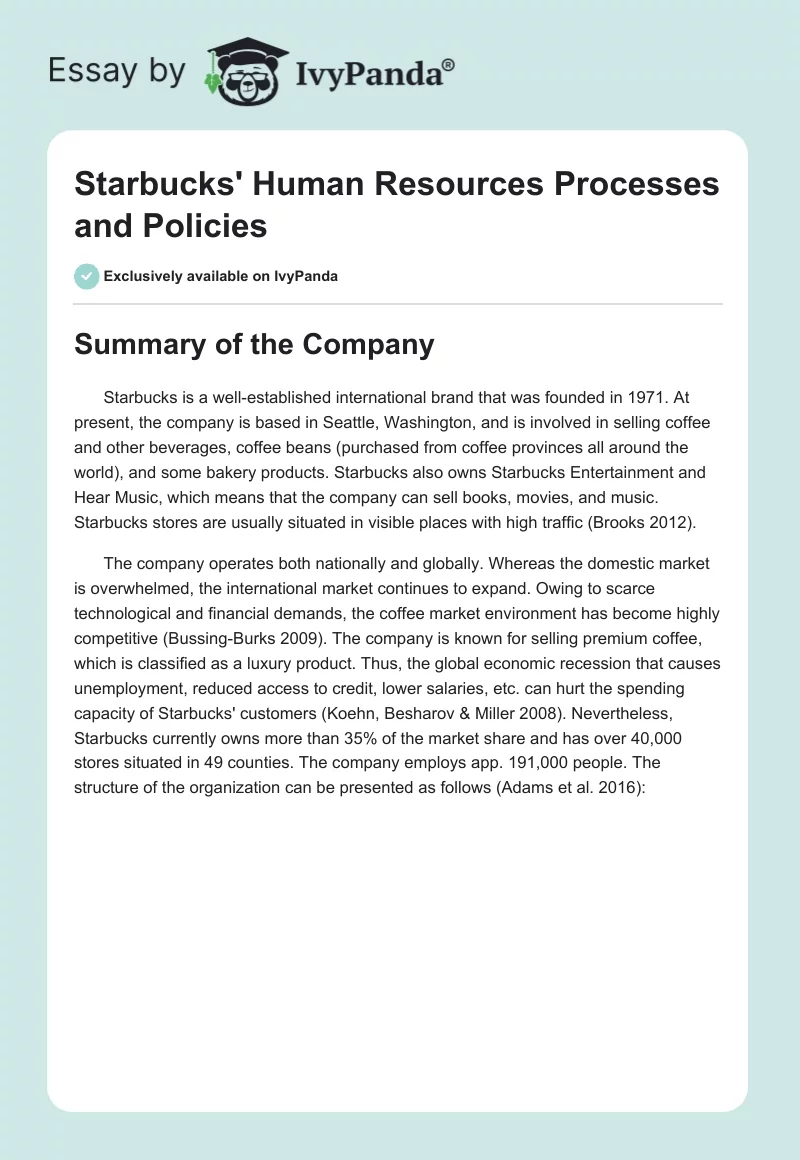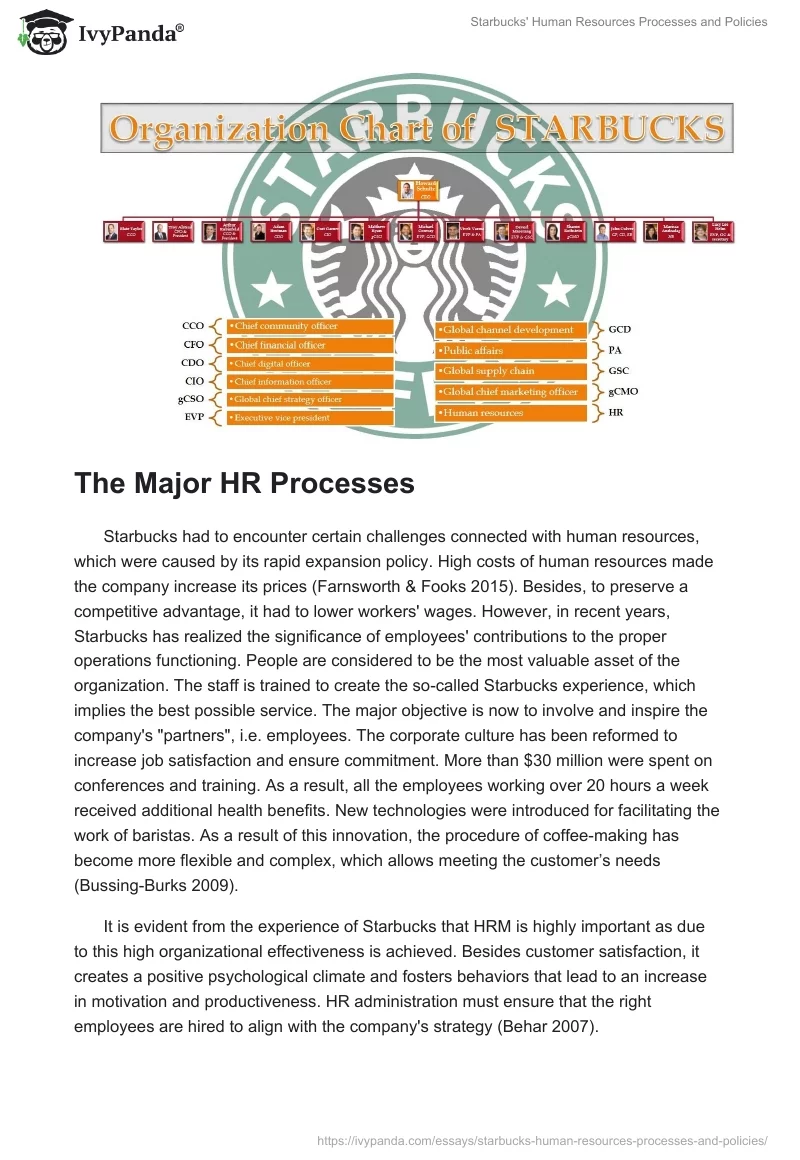Summary of the Company
Starbucks is a well-established international brand that was founded in 1971. At present, the company is based in Seattle, Washington, and is involved in selling coffee and other beverages, coffee beans (purchased from coffee provinces all around the world), and some bakery products. Starbucks also owns Starbucks Entertainment and Hear Music, which means that the company can sell books, movies, and music. Starbucks stores are usually situated in visible places with high traffic (Brooks 2012).
The company operates both nationally and globally. Whereas the domestic market is overwhelmed, the international market continues to expand. Owing to scarce technological and financial demands, the coffee market environment has become highly competitive (Bussing-Burks 2009). The company is known for selling premium coffee, which is classified as a luxury product. Thus, the global economic recession that causes unemployment, reduced access to credit, lower salaries, etc. can hurt the spending capacity of Starbucks’ customers (Koehn, Besharov & Miller 2008). Nevertheless, Starbucks currently owns more than 35% of the market share and has over 40,000 stores situated in 49 counties. The company employs app. 191,000 people. The structure of the organization can be presented as follows (Adams et al. 2016):

The Major HR Processes
Starbucks had to encounter certain challenges connected with human resources, which were caused by its rapid expansion policy. High costs of human resources made the company increase its prices (Farnsworth & Fooks 2015). Besides, to preserve a competitive advantage, it had to lower workers’ wages. However, in recent years, Starbucks has realized the significance of employees’ contributions to the proper operations functioning. People are considered to be the most valuable asset of the organization. The staff is trained to create the so-called Starbucks experience, which implies the best possible service. The major objective is now to involve and inspire the company’s “partners”, i.e. employees. The corporate culture has been reformed to increase job satisfaction and ensure commitment. More than $30 million were spent on conferences and training. As a result, all the employees working over 20 hours a week received additional health benefits. New technologies were introduced for facilitating the work of baristas. As a result of this innovation, the procedure of coffee-making has become more flexible and complex, which allows meeting the customer’s needs (Bussing-Burks 2009).
It is evident from the experience of Starbucks that HRM is highly important as due to this high organizational effectiveness is achieved. Besides customer satisfaction, it creates a positive psychological climate and fosters behaviors that lead to an increase in motivation and productiveness. HR administration must ensure that the right employees are hired to align with the company’s strategy (Behar 2007).
Recruitments and Hiring Process
The recruitment process consists of attracting, interviewing, selecting, and hiring a competent team for different jobs the company can offer. There exist two types of recruitment: 1) internal recruitment, which deals with recruiting those who have already been hired by the company; 2) external recruitment, which concerns only new specialists who have no connection to the company. While recruitment is aimed to attract applicants, the process of hiring has to start with determining and selecting which candidates have the best characteristics (Adams et al. 2016).
In Starbucks, the process of recruitment and hiring can be divided into the following major stages (Bussing-Burks 2009):
- analyzing job requirements and developing a set of characteristics a candidate should possess;
- using various networks and advertisement methods to attract applicants;
- matching CVs of candidates to the job requirements and testing them using several assessment tools (including personal and professional assessment);
- interviewing those applicants who successfully passed all the tests and discussing their qualities, skills, and goals as well as their expectations from the company;
- negotiating contract conditions and agreeing.
If we go into detail, all candidates have to submit their CVs (personal information, characteristics, and professional experience including references from the previous work places); after the information has been analyzed by the HR-team, the selected applicants receive notifications allowing them to pass on to the next round of the recruitment process (which is rather lengthy and may take more than two weeks depending on the number of candidates). In most cases, the interview is conducted by a store manager; however, panel discussion may be required for making decisions about higher leadership positions as the qualifications of the applicant must be proven (Bussing-Burks 2009).
A candidate is expected to answer several questions ranging from background assessment to general knowledge of the industry and customer service. There are also questions of the ethical character that show interviewers if the person would be able to fit in. For internal recruitment, the company promotes new positions from within, whereas external methods include both walk-ins and referrals that allow the employees to recommend candidates (Adams et al. 2016).
Annual Appraisal
Annual performance appraisal of the staff is necessary for identifying whether the employees make a valuable contribution to the company. Moreover, it is used for career planning, training, promotion, and termination decisions (Brooks 2012).
The annual appraisal at Starbucks consists of two stages: 1) performance assessment; 2) sharing feedback among all the employees. The company makes use of customer comment cards, which are opinion polls allowing customers to share their impressions of the quality of goods and services. This way of appraisal is an evident strength of the company as in most cases customers do not know any of the employees personally, which means that their assessment is likely to be impartial. Those employees who have high scores according to customers’ opinions usually receive bonuses (Brooks 2012).
However, the second stage of the process – the so-called 360-degree feedback – is often classified as a weakness rather than a strength in the company’s appraisal system. The point is that not every employee is ready to accept feedback, especially from his/her subordinates. There are only 9 people who work in one booth so personal attitude that they all have to each other does not let them be objective (taking into consideration that they all strive to receive a reward) (Bussing-Burks 2009).
Award System
The system of performance award is another strong side of the company as it provides an opportunity to increase job satisfaction at all levels. The awards include (Bussing-Burks 2009):
- Manager of the Quarter Award (identifies a store manager in each of the areas who has shown excellent leadership qualities and increased the efficiency of the workflow);
- Manager of the Year Award (is given to the most professional quarter manager for a particular fiscal year);
- District Manager of the Year Award (is given to the best district manager of the year in five categories: Partner, Business, Customer, Rookie, and Overall);
- Spirit of Starbucks Award (recognizes those employees who are committed to the culture of the company and provide the greatest assistance to their partners);
- Team Spirit of Starbucks Award (is granted to teams consisting of more than 3 people);
- Bravo Award (is given to those who manage to achieve outstanding results);
- Team Bravo Award (the same but for a team);
- Ten Year Service Award (for uninterrupted employment);
- Fifteen Year Service Award;
- Twenty Year Service Award;
- Twenty-Five Year Service Award.
Disciplinary Actions and Policies
The company provides Standards of Business Conduct to each of its employees for them to be able to make effective decisions in every situation. Starbucks does not emphasize punishments that may follow as a result of wrong actions. Instead, it concentrates on helping its partners to enhance their willpower for handling stressful situations. There are special books and training role plays for achieving automatic responses. The company adheres to the method called LATTE (which stands for Listen, Acknowledge, Take Action, Thank, and Explain). Those who manage to show excellent discipline with both customers and managers receive additional awards. Thus, the company helps its staff develop useful working habits through planning and identifying the appropriate pattern of behavior in advance and then resorting to the developed blueprints (Adams et al. 2016).
Despite the seeming liberalism of this approach, it has its weaknesses. The new team member may find it difficult to handle situations involving inadequate customers, which can cause panic. The point is that it is not always possible to give standard answers since clients do not have standard complaints or questions. Thus, the existing blueprints are too vague and general to provide the solution to specific conflicts. Moreover, the breach of the discipline code is punishable, which creates even more pressure.
As far as the dress code is concerned, it has recently been made more liberal. Now, the employees can use a range of colors for their shirts (gray, brown, navy, denim, etc.). They are also free to choose their hair color (Adams et al. 2016). On the one hand, it reflects their personalities and gives them more freedom. On the other – it deprives the company of the well-recognized image and consistency.
Employees’ Satisfaction and Engagement
To increase job satisfaction and engagement, the company provides health benefits, financial support, and encourages its employees to take part in various development programs. The satisfaction level is measured two times in a fiscal year to be able to make changes if the new policy is ineffective. The following incentives have been introduced to increase job satisfaction (Bussing-Burks 2009):
- both full- and part-time partners can receive college tuition; the company will pay the biggest portion of the sum and may even offer to pay for the full tuition for juniors and seniors;
- those who cannot attend classes can study online (currently, there are 40 programs available online for the employees);
- the company provides full health insurances;
- the employees have paid vacation time;
- Starbucks gives its stocks to the staff members every year; this benefit can significantly increase engagement as the employees of the company acquire the feeling of belonging;
- working for Starbucks gives one a right to have a pound of coffee beans or tea once a week; besides, the employees get a 30% discount for products and can drink any beverage for free during the breaks.
Attendance
One of the most evident disadvantages of the company from the employees’ perspective is that it does not provide any sick days. Attendance is a must, which implies that if you fall sick it is your responsibility, and the expenses are not covered by the company. Only if you are a manager or at least an assistant manager, you can get compensation (Bussing-Burks 2009).
Recommendations
- Starbucks should be more careful about its strategies of further expansion as numerous stores across the globe have already been closed because of the redundancy of the labor force.
- It should not rely on social media for promotion and develop its communication channels instead.
- The company should reconsider its marketing strategies for being more appealing to low-income customers.
- It should increase the seating capacity of cafés for being able to serve more customers since currently, a few employees are really necessary to meet the needs of such a restricted number of people.
- The orders must be more customized as now stores are frequently out of inventory to meet all customers’ requirements.
- The company must be more precise about discipline standards for the employees to understand the necessary actions clearly.
- Baristas should specify what additional services the customer can receive free of charge as currently the company only emphasizes its luxury goods orientation scaring off middle-class clients.
- The automation process must be made clear to all the employees through regular training programs that should be obligatory for everyone.
- General and specialized training courses should be differentiated as every employee must possess all the basic skills in case temporary replacement is required.
- Sick days must be introduced.
Reference List
Adams, B, Gans, J, Hayes, R, & Lampe, R 2016, Does organizational form drive competition? Evidence from coffee retailing, National Bureau of Economic Research, Cambridge.
Behar, H 2007, It’s not about the coffee: leadership principles from a life at Starbucks, Penguin, London.
Brooks, BW 2012, ‘Starbucks: maintaining a clear position’, Journal of the International Academy for Case Studies, vol. 18, no. 3, pp. 39-48.
Bussing-Burks, M 2009, Starbucks, ABC-CLIO, Santa-Barbara.
Farnsworth, K & Fooks, G 2015, ‘Corporate taxation, corporate power, and corporate harm’, The Howard Journal of Criminal Justice, vol. 54, no. 1, pp. 25-41.
Koehn, NF, Besharov, M & Miller, K 2008, ‘Starbucks coffee company in the 21st century’, Harvard Business School, Case Study, vol. 12, no. 4, pp. 789-808.


